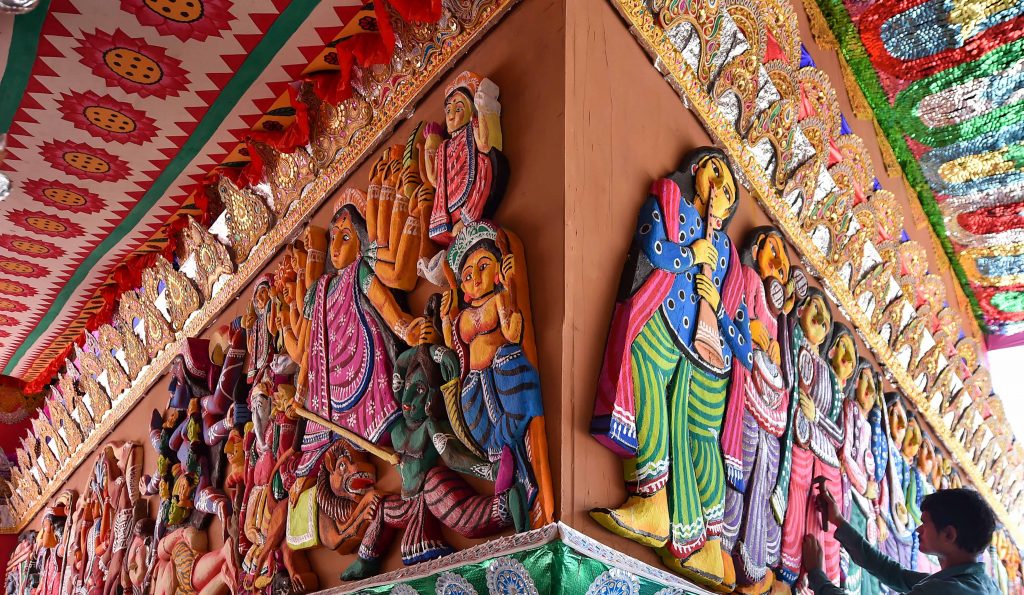It has been time and again said that during one’s life time among the wishes on the bucket list there should be a ‘must visit Kolkata once during the Durga Puja festivities’. The various themes on offer at the community Durga Pujas, the yummy food on road side stalls, the lighting, the decorations, the camaraderie, the crowd, the cacophony of pleasant as well as shrill sounds – all make it memorable lifetime experience. It forever remains etched in the memory.
This year also the community pujas themes on offer are worthy of mention. From the cross-border airstrike in Pakistan’s Balakot to the National Register of Citizens (NRC) and Odisha pattachitra, myriad themes mark the community puja marquees as festive fervour grips the eastern metropolis of Kolkata with the biggest socio-cultural carnival of Bengalis. The pujas are supposed to begin Friday, but since October Sunday last, crowds have filled up the Kolkata roads, lanes and by lanes.
Close to 3,000 community pujas – big, medium and small – are being organised in Kolkata, with around 25,000 more in the districts, besides the time-honoured elite family celebrations, plunging Bengal into festivities, merriment and religiosity.
The puja rituals, however, began on Thursday itself, with Panchami – the fifth day of the lunar calendar – the puja eve – making way for Shashthi (the sixth day of the lunar calendar) in the evening, as per the Hindu almanac.
Kalparamvo (the beginning of the puja), and Bodhan (the consecration of Durga’s idol) were being performed by the priests, with the devout crowding around the idol in obeisance.
But with the new trend – started by Chief Minister Mamata Banerjee – of inaugurating the marquees even before Mahalaya, the revelers have hit the streets from last Sunday itself – virtually extending the celebrations into a 10 -day carnival.
As huge number of pandal-hoppers descended on the city from the suburbs, rest of India and from across the globe, the marquees that have sprung up left, right and centre, showcase remarkable creativity giving stiff competition to one another.
Current events which have had a deep impact on the politics and social life of the country, have found an echo in the festival, the biggest in this part of the world.
Central Kolkata’s Young Boys Club Sarbojanin Durga Puja Committee is celebrating its golden jubilee this year by simulating scenes from the Balakot air strike, in which the Indian Air Force (IAF) jets bombed and destroyed a terror training camp in Pakistan.
The organisers have positioned 65 models of Indian Air Force personnel and terrorists near the entrance as a model of an IAF aircraft hovered over. There is also a life-size model of IAF pilot Wing Commander Abhinandan Varthaman, who had shot down an F-16 fighter jet of the Pakistan Air Force before he was captured.
Against the backdrop of panic over a possible future NRC exercise gripping the state, the Rajdanga Naba Uday Sangha puja is drawing a huge crowd by envisioning its marquee around the theme of ‘refugee’.
Shuttlecocks, standing for refugees and badminton racquets – representing two countries – have been slotted in front of the marquee, to delineate the message of two countries lobbing the refugees to each other’s side.
While the political tone is hard to miss, the fact that the puja committee president Sushanta Ghosh is a Trinamool Congress leader and chairman of Kolkata Municipal Corporation’s Borough number 13 makes the intent more obvious.
Moving away from the political slugfest, the famed Tridhara Sammilani of South Kolkata has chosen to drive home some ‘green lessons’ to the public by making its premises plastic free. The puja organsiers say they work with the Kolkata Municpal Corporation for waste management, and adhere to all green norms.
The rituals that start off on Shashthi come to an end on Bijaya Dashami, when the idols of the goddess and her children are immersed by teary-eyed devotees in ponds, lakes and rivers across the state, adding to the pollution of the water bodies and waterways.
This year, however, many of the committees complained about the lack of funds due to the economy slowdown. It has dimmed the lights of Bengal’s biggest festival this time, forcing Durga puja organisers to scale down celebrations due to shrinking sponsorship.
Not just small-budget pujas, big-ticket ones have also curtailed their budget by nearly 15 per cent to 30 per cent mostly compromising on marquee decoration.
On an average, setting up a theme-based marquee for the five-day fiesta, replete with safety arrangements and basic amenities, costs anything between Rs 12 lakh and Rs 30 crore.
“Owing to economic slowdown, we failed to achieve our target of Rs 65 lakh. We are running short of Rs 20 lakh. Most sponsors, this time, either declined to make a contribution or paid less than what they do,” Sudipto Kumar, an official of Deshapriya Park community puja in south Kolkata, said. Incidentally, this is one puja everyone has on their visit list. At an average starting from the morning, this puja gets footfalls at an average of 15 lakh every day.
Echoing similar sentiments, Ekdalia Evergreen Club said several sponsors have gone back on their promise, citing the ailing economy.
“Some sponsors, who had signed a contract with us, have also backed out. In 2008-2009 (during global recession), we had faced a similar situation,” club secretary Gautam Mukherjee informed.
The situation has gone worse for small-budget Durga pujas committees, with some of the organisers opting for a marquee without any distinct theme.
“We had decided to adorn our pandal with glass structures, but lack of funds forced us to find an alternative in plaster of Paris,” said Ashok Deb, an official of a Durga Puja committee in North 24 Parganas district.
PNN
